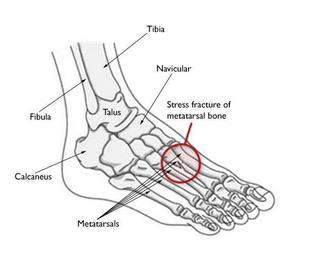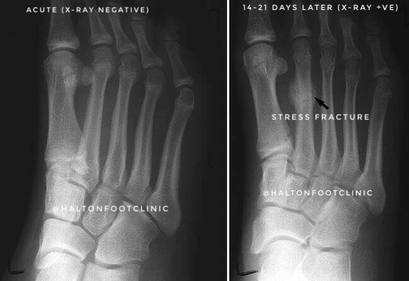|
What is a stress fracture?
Unlike a fracture caused by an obvious injury, a stress fracture involves a small crack in the bone as a result of the amount of stress put on a particular bone of the foot exceeding the body’s ability to adapt to it. All weight-bearing bones of the foot can be prone to a stress fracture, however this injury is most commonly seen at the metatarsals. What causes a stress fracture?
Most commonly affected gender: Studies show that females are more prone to stress fractures in comparison to their male counterparts. This may, in part, be due to the “female athlete triad” which states that when a women participates in sports, she may be more prone to 3 illnesses: eating disorders, decreased bone mineral density, and dysfunction of the menstrual cycle. As a female’s bone mass decreases, the chances of getting a stress fracture increases. Symptoms:
When to visit a foot specialist: If any of the following symptoms above are present, seek treatment, as a fracture that fails to heal (non-union) or heal properly (malunion) may require surgical intervention. What Can I Expect During The Visit
Recovery Recovery ultimately depends on the severity of the fracture, however most stress fractures heal within 6-8 weeks. One of the most common mistakes people make is returning to activity too soon. Being sidelined with an injury can definitely be frustrating, but returning to activity too soon puts you at risk for larger, harder to heal stress fractures that can taken even longer to heal. It is important to confirm with your foot specialist that full healing has occurred before returning to activity. Slowly increase the intensity, duration and frequency of the activity with lots of rest in between to give your bone time to adapt to the new demands placed on it. Prevention
Have you ever experienced a stress fracture? Let us know of your rehab process in comments section! Think you have a stress fracture? Call our office today!
2 Comments
|
ArchivesCategories |
Copyright © 2019



 RSS Feed
RSS Feed